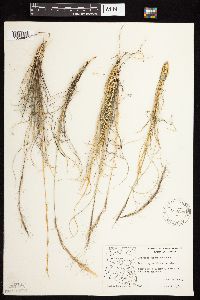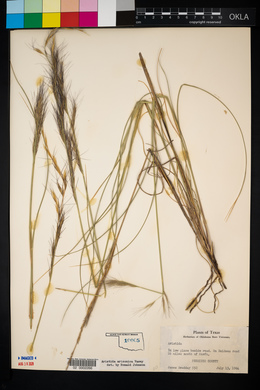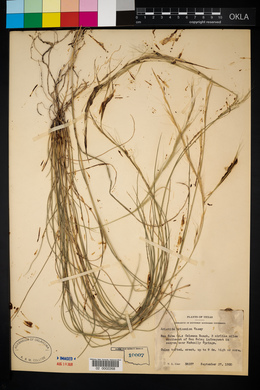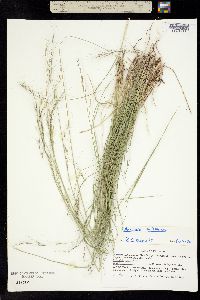
|
|
|
|
Family: Poaceae
Arizona Three-Awn, more...Arizona threeawn
|
Plants perennial; usually cespitose, occasionally with rhizomes. Culms 30-80(100) cm, erect, unbranched. Leaves mostly basal; sheaths usually longer than the internodes, mostly glabrous, throat sometimes with hairs, not disintegrating into threadlike fibers; collars glabrous or with hairs at the sides; ligules 0.2-0.4 mm; blades 10-25(30) cm long, 1-3 mm wide, usually flat, often curling like wood shavings when mature, glabrous. Inflorescences spikelike panicles, 10-25 cm long, 1-3 cm wide; nodes glabrous or with straight, about 0.5 mm hairs; primary branches 2-6 cm, appressed, without axillary pulvini, with 2-8 spikelets. Glumes 10-15(18) mm, brownish, acuminate to awned, awns to 3 mm; lower glumes slightly shorter than to equaling the upper glumes, 1-2-veined; calluses 1-1.8 mm; lemmas 12-18 mm, glabrous, rarely sparsely pilose, terminating in a 3-6 mm twisted column, junction with the awns not conspicuous; awns 20-35 mm, straight to curved basally, ascending distally, not disarticulating at maturity; central awns 20-35 mm; lateral awns slightly shorter than the central awns; anthers 3, 1.3-1.9 mm. 2n = 22. Aristida arizonica grows in pine, pine-oak, and pinyon-juniper woodlands from the southwestern United States to southern Mexico. It may be confused with A. purpurea var. nealleyi, but differs in having flat, curly leaf blades and longer awns. Perennials, Terrestrial, not aquatic, Rhizomes present, Basal sheaths fibrous, old leaves persistent at base of plant, Stems nodes swollen or brittle, Stems erect or ascending, Stems caespitose, tufted, or clustered, Stems terete, round in cro ss section, or polygonal, Stem internodes solid or spongy, Stems with inflorescence less than 1 m tall, Stems, culms, or scapes exceeding basal leaves, Leaves mostly basal, below middle of stem, Leaves conspicuously 2-ranked, distichous, Leaves sheathing at base, Leaf sheath mostly open, or loose, Leaf sheath smooth, glabrous, Leaf sheath hairy, hispid or prickly, Leaf sheath hairy at summit, throat, or collar, Leaf sheath and blade differentiated, Leaf blades linear, Leaf blades very narrow or filiform, less than 2 mm wide, Leaf blades 2-10 mm wide, Leaf blades mostly flat, Leaf blades mostly glabrous, Ligule present, Ligule a fringe of hairs, Inflorescence terminal, Inflorescence a contracted panicle, narrowly paniculate, branches appressed or ascending, Inflorescence solitary, with 1 spike, fascicle, glomerule, head, or cluster per stem or culm, Inflorescence with 2-10 branches, Flowers bisexual, Spikelets sessile or subsessile, Spikelets laterally compressed, Spikelet l ess than 3 mm wide, Spikelets with 1 fertile floret, Spikelets solitary at rachis nodes, Spikelets all alike and fertille, Spikelets bisexual, Spikelets disarticulating above the glumes, glumes persistent, Spikelets disarticulating beneath or between the florets, Rachilla or pedicel glabrous, Glumes present, empty bracts, Glumes 2 clearly present, Glumes equal or subequal, Glumes equal to or longer than adjacent lemma, Glumes awned, awn 1-5 mm or longer, Glumes 1 nerved, Lemma coriaceous, firmer or thicker in texture than the glumes, Lemma 3 nerved, Lemma glabrous, Lemma apex acute or acuminate, Lemma distinctly awned, more than 2-3 mm, Lemma with 3 awns, Lemma awn 2-4 cm long or longer, Lemma awned from tip, Lemma awns straight or curved to base, Lemma awn twisted, spirally coiled at base, like a corkscrew, Lemma margins inrolled, tightly covering palea and caryopsis, Lemma straight, Callus or base of lemma evidently hairy, Callus hairs shorter than lemma, Palea present, we ll developed, Palea membranous, hyaline, Palea shorter than lemma, Palea 2 nerved or 2 keeled, Stamens 3, Styles 2-fid, deeply 2-branched, Stigmas 2, Fruit - caryopsis, Caryopsis ellipsoid, longitudinally grooved, hilum long-linear.
FNA 2003, Gould 1980 Common Name: Arizona threeawn Duration: Perennial Nativity: Native Lifeform: Graminoid General: Tufted perennial in small clumps with erect stems 30-80 cm, unbranched; sheaths longer than internodes, rounded, striate with hairs at throats and on either side of the collar; otherwise mostly glabrous. Vegetative: Mostly basal leaves, blades 10-25 cm long, 1-3 mm wide, firm, mostly flat but occasionally folded or involute on drying; ligule a short fringe of hairs less than 0.5 mm. Inflorescence: Spikelike panicles 10-25 cm long, 1-3 cm wide, contracted and with few flowers, nodes glabrous or with straight hairs to 0.5 mm, primary branches 2-6 cm, appressed and bearing 2-8 spikelets; glumes equal, brownish, acuminate to awned with awns to 3 mm, lower glumes slightly shorter than upper glumes, 1-2 veined; lemmas 12-18 mm, glabrous to rarely sparsely pilose, terminating in a 3-6 mm twisted column, junction with awns not conspicuous; awns 20-35 mm, straight to curved basally, ascending distally, not disarticulating at maturity, central awns 20-35 mm, lateral awns slightly shorter than central awns. Ecology: Found on dry rocky sites especially in the oak-pine, pi-on-juniper woodlands from 4,500-8,000 (1372-2438 m); flowers July-October. Distribution: AZ, NM, CO, UT, w TX, n MX Notes: A. arizonica is a perennial three awn with narrow, few-flowered panicles. The spikelets and awns are somewhat large, with awns 2 to 3.5 cm long. There is often a cluster of basal leaves. These can be narrow and straight, but are sometimes distinctively wide, flat, and curled, like ribbon attached to a Christmas present. Can be confused with A. purpurea var. nealleyi but differs in having flat, curly leaf blades and longer awns. Ethnobotany: Unknown Etymology: Aristida is from the Latin arista for awn, while arizonica means of or from Arizona. Synonyms: None Editor: SBuckley 2010, AHazelton 2015 |
|
|
|




































































































